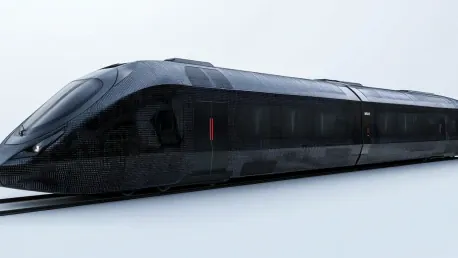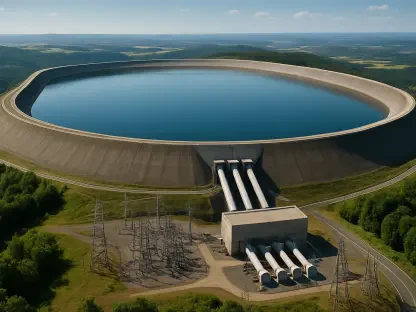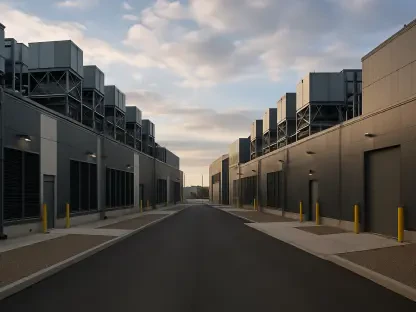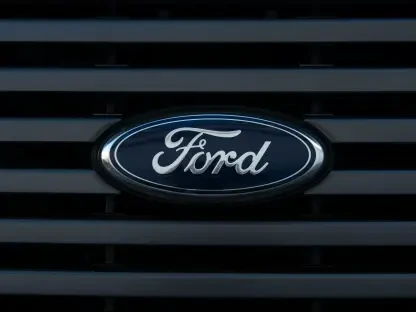The debut of the world’s first carbon fiber passenger train, the CETROVO 1.0 Carbon Star Express, has brought both excitement and anticipation for the future of mass transit in China. Developed by leading Chinese companies, this innovative train represents a giant leap forward in railway technology through its use of carbon fiber for key structural elements. This marks a significant departure from the conventional all-metal construction traditionally used in train manufacturing.
A New Era in Train Construction
The Innovation of Carbon Fiber
The CETROVO 1.0 Carbon Star Express incorporates cutting-edge design principles, most notably the extensive use of carbon fiber in its load-bearing structures, such as the body and bogie frames. This material choice has resulted in a train that is 11% lighter than conventional models of the same size. As a consequence, energy consumption is reduced by 7%, leading to enhanced environmental sustainability. This advancement is significant because carbon fiber offers a superior strength-to-weight ratio compared to traditional materials.
Carbon fibers are renowned for their durability, stiffness, and high tensile strength, which are five times stronger than steel while weighing only a quarter of its mass. This property makes carbon fiber an ideal candidate for manufacturing lightweight yet robust rail vehicles. The CETROVO’s use of carbon fiber not only contributes to its strength and longevity but also ensures a smoother and quieter ride for passengers due to reduced vibration. These characteristics align perfectly with the growing demand for sustainable and efficient public transportation solutions.
Environmental and Operational Benefits
The lightweight nature of the CETROVO 1.0 brings tangible benefits in terms of operational efficiency and environmental impact. By being 11% lighter, the train reduces the energy required for its operation, consequently lowering CO2 emissions. It is estimated that the Carbon Star Express can save approximately 130 tons of CO2 emissions annually, an impressive feat comparable to planting 100 acres of trees. This approach not only meets mass transportation needs but also significantly contributes to China’s sustainability goals, positioning the country as a leader in green technology.
Operating on the 37.2-mile Metro Line 1 in Qingdao, this train efficiently connects 41 stations, serving as a core component of the city’s urban transit system. In addition to their light weight, carbon fiber trains exhibit excellent impact resistance and extended structural lifespan, reducing the need for frequent maintenance and repairs. This not only translates to financial savings for transit authorities but also ensures fewer disruptions for passengers. The CETROVO 1.0 is thus a game-changer in the pursuit of reliable and sustainable public transportation.
Technological Advancements and Testing
Development and Trials
The development phase of the CETROVO 1.0 Carbon Star Express began in 2021, with extensive research and testing phases that showcased its innovative features. Over the course of several years, engineers and scientists subjected the train to rigorous testing to ensure its reliability and performance. Between July and December 2024, the CETROVO underwent successful trial runs, achieving speeds of 87 mph and surpassing the current average speed of 49.7 mph for Chinese metro trains. The train’s performance exceeded expectations, proving its capabilities in real-world conditions.
The trials involved more than 50 technical evaluations and comprehensive system-to-vehicle testing. This thorough assessment was crucial in preparing the CETROVO for passenger use. By conducting meticulous trials, developers ensured the train met the highest standards of safety, efficiency, and passenger comfort. The train successfully passed a passenger trial phase, culminating in its official approval on January 5, 2025. This marked a pivotal moment, paving the way for the CETROVO’s introduction into regular service and highlighting China’s commitment to innovation in mass transit.
Automation and Intelligent Safety Features
One of the standout features of the CETROVO 1.0 Carbon Star Express is its fully automated operation, allowing it to run for extended durations with fewer downtimes compared to manned trains. Automation enhances the train’s efficiency by minimizing human error and optimizing operational schedules. In addition to automation, the train is equipped with advanced safety systems that further bolster its appeal. An anti-collision early warning system and an obstacle detection system are among the intelligent features designed to enhance passenger safety.
The obstacle detection system can automatically stop the train in emergencies, providing an added layer of security for passengers. These safety measures ensure that the CETROVO maintains a high standard of safety, even in challenging scenarios. The integration of intelligent technology into the train’s operations aligns with broader trends in the transportation industry, where automation and smart systems are increasingly adopted to improve safety and efficiency. As a result, the CETROVO 1.0 stands out as a premier example of how cutting-edge technology can redefine mass transit.
The Future of Mass Transit
Enhancing Efficiency and Sustainability
The CETROVO 1.0 Carbon Star Express represents a pioneering stride in the quest for efficient and sustainable mass transit solutions. Its introduction underscores China’s leadership in innovative rail transport, setting a benchmark for the global industry. By significantly reducing emissions and enhancing operational efficiency, the Carbon Star Express aligns with global environmental goals and supports the transition to greener transportation systems. As urban populations continue to grow, the demand for efficient mass transit solutions will only increase, making innovations like the CETROVO essential.
The successful implementation of the CETROVO 1.0 also opens the door to future developments in rail technology. As other countries observe the benefits and performance of this carbon fiber train, it is likely that more will follow China’s lead in adopting similar technologies. This could lead to a broader transformation in rail transit, characterized by lightweight materials, intelligent systems, and a focus on sustainability. The CETROVO has demonstrated that it is possible to achieve significant advancements in mass transit while simultaneously reducing environmental impact.
A Call to Action
The unveiling of the world’s first carbon fiber passenger train, the CETROVO 1.0 Carbon Star Express, has generated considerable buzz and high hopes for the future of public transportation in China. Engineered by prominent Chinese companies, this groundbreaking train embodies a major leap in railway technology by incorporating carbon fiber into its primary structural components. This innovative approach marks a departure from the traditional reliance on all-metal construction in train manufacturing.
The Carbon Star Express offers several advantages over conventional trains. First, using carbon fiber significantly reduces the train’s weight, enhancing energy efficiency and decreasing operational costs. Second, carbon fiber is known for its strength and durability, which increases the train’s resilience and longevity. Finally, this technological advancement could pave the way for further innovations in the global railway industry, potentially influencing train designs worldwide.
With the introduction of the CETROVO 1.0 Carbon Star Express, China positions itself at the forefront of railway innovation, setting a new standard that may inspire other nations to explore similar advancements in public transportation.









